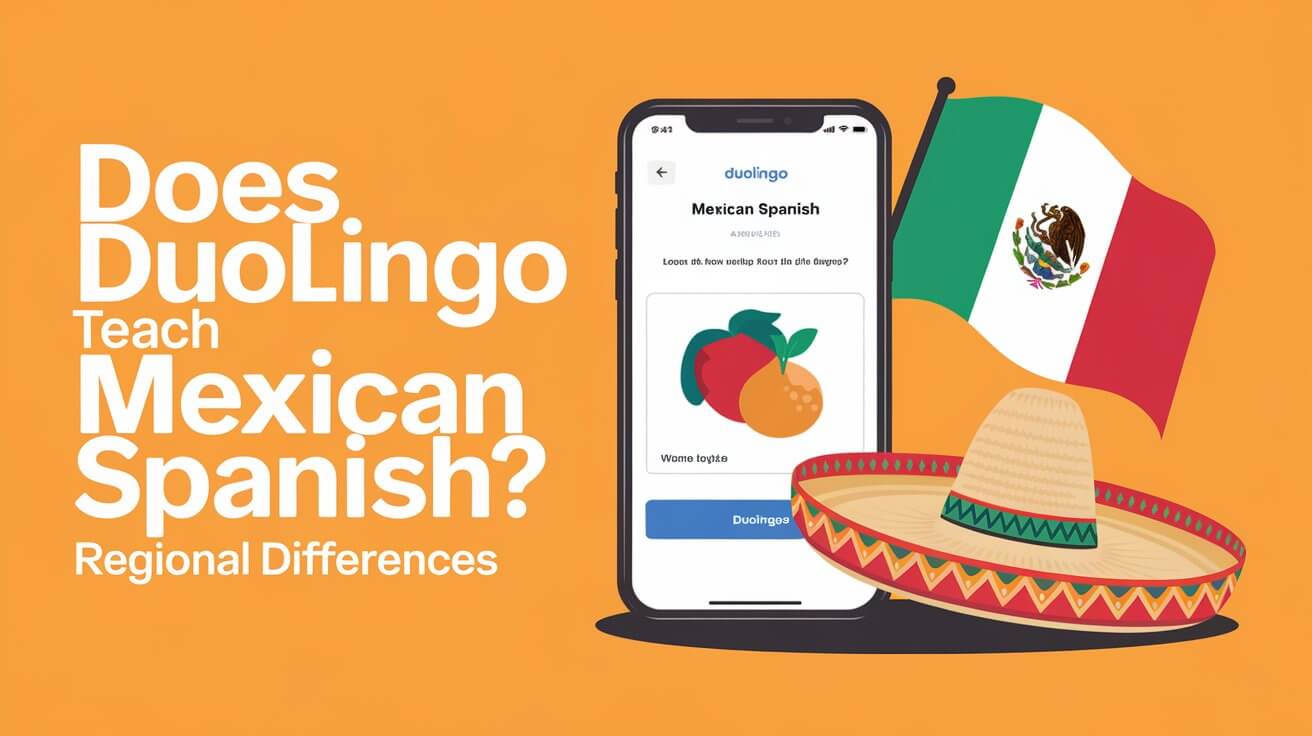Are you thinking about learning Spanish with Duolingo? You might wonder if it teaches Mexican Spanish. Duolingo focuses on Latin American Spanish, which is spoken by about 500 million people worldwide.
Duolingo makes learning Spanish fun with its gamified approach. Lessons are short and fit your learning style. This helps you learn basic conversations and then more complex grammar and words.
Key Takeaways
- Duolingo’s Spanish course mainly teaches Latin American Spanish, with a big focus on Mexican dialect.
- Mexican Spanish uses informal words like “tú” and special words like “güey” and “chido”.
- Duolingo covers many Latin American Spanish types, including accents and words from Colombia, Argentina, and Peru.
- Even though it includes some Castilian Spanish, Duolingo doesn’t go deep into Spanish from Spain.
- Duolingo’s learning style is personalized. It adjusts to your pace, offering goals, unit choices, and ways to practice and track your progress.
Does Duolingo Teach Mexican Spanish
Duolingo’s Spanish course mainly focuses on Latin American Spanish, especially the Mexican dialect. It teaches essential vocabulary, grammar, and pronunciation specific to Mexican Spanish. While it touches on Castilian Spanish, the main focus is on Mexican Spanish, which is very popular among learners.
Latin American Spanish Focus
Duolingo’s Spanish lessons aim to teach the nuances of Latin American Spanish. It covers regional dialects and cultural contexts. The app also includes cultural notes to help learners understand the language in everyday situations.
Mexican Dialect Emphasis
Duolingo especially focuses on the Mexican dialect within Latin American Spanish. It teaches common Mexican phrases, slang, and idioms. It also highlights the unique pronunciation and grammar of Mexican Spanish. This helps learners communicate well in one of the most spoken Spanish forms.
Pronunciation and Grammar Features
Duolingo’s Spanish course pays a lot of attention to pronunciation and grammar of the Mexican dialect. Users can practice their accent with native speaker recordings. The app also covers the unique grammatical structures and verb conjugations of Mexican Spanish. This helps learners understand the language well.
Duolingo’s Spanish course focuses on the Mexican variant of Latin American Spanish. It ensures learners become proficient in this widely used form of Spanish. Duolingo’s focus on pronunciation, grammar, and culture makes it a great platform for mastering Mexican Spanish.
Key Differences Between Mexican and Spain Spanish
The Spanish language has notable differences between Mexican and Castilian (from Spain) variations. These differences are seen in vocabulary, grammar, and pronunciation. Each dialect has its own unique way of expressing itself.
One key difference is in personal pronouns. Castilian Spanish uses “vosotros” for informal plural “you.” Mexican Spanish, on the other hand, uses “ustedes” for both formal and informal plural “you.”
In terms of pronunciation, Mexican Spanish doesn’t have the “th” sound (known as the ceceo) found in Castilian Spanish. Instead, it uses the “s” sound, known as seseo. Mexican Spanish also includes many words from indigenous languages like Nahuatl. This adds a unique cultural touch to the language.
| Feature | Castilian Spanish | Mexican Spanish |
|---|---|---|
| Plural “You” | Vosotros | Ustedes |
| Pronunciation of “c” and “z” | Ceceo (th sound) | Seseo (s sound) |
| Vocabulary | Primarily Castilian Spanish | Incorporates indigenous words (e.g., Nahuatl) |
These differences between Mexican and Castilian Spanish make the Spanish-speaking world richer and more diverse. They reflect the unique cultural and historical influences on each dialect.
“Mexican Spanish has a distinct personality that sets it apart from the Castilian variety, making it a vibrant and ever-evolving form of the language.”
Popular Mexican Spanish Features on Duolingo
Duolingo, a top language app, introduces users to Mexican Spanish. It focuses on key vocabulary, phrases, and cultural context. This helps learners grasp the unique Mexican Spanish dialect.
Essential Mexican Vocabulary
Duolingo teaches common Mexican words like “totopos” (tortilla chips) and “jitomate” (tomato). It also covers everyday items and slang. This prepares learners to use cultural expressions in Spanish confidently.
Common Phrases and Expressions
Duolingo includes popular phrases like “¿Qué onda?” (What’s up?) and “Chido” (Cool). These phrases help users have natural conversations. Understanding these idioms makes communication in Mexican scenarios easier.
Cultural Context Learning
Duolingo emphasizes cultural immersion in Mexico. It teaches about customs, traditions, and unique expressions. This helps learners appreciate the richness of Mexican Spanish.
While Duolingo is great for learning Mexican Spanish, it might not cover all regional variations. Additional resources and native speakers can improve learning. This is especially true for mastering the Mexican Spanish dialect.
Duolingo’s Spanish Learning Methods
Duolingo uses many language learning techniques to help you learn Spanish. The app makes learning Spanish grammar lessons and vocabulary fun. It keeps you engaged and motivated as you learn.
Duolingo’s duolingo spanish course includes interactive exercises. These cover reading, writing, listening, and speaking. You start with simple words and sentences, then move to more complex grammar and conversations.
The app tracks your progress and adjusts the difficulty level. This ensures you learn at your own pace.
Duolingo also uses gamification to make learning fun. You can compete with others, earn virtual currency, and track your daily progress. These elements help you stay motivated and engaged.
The app uses spaced repetition to help you remember words and concepts. It presents them at the right time to reinforce your memory. This helps you retain what you’ve learned over time.
Duolingo lets you create a personalized learning path. You can focus on areas you find challenging or relevant to your goals. This makes learning more effective and enjoyable for you.
“Duolingo’s approach to teaching Spanish is truly innovative, combining gamification, personalized learning, and proven language acquisition techniques to create an engaging and effective learning experience.”
Duolingo’s language learning techniques make learning Spanish grammar lessons and vocabulary fun and accessible. The app’s interactive and adaptive duolingo spanish course has helped millions worldwide on their language learning journey.
Spanish Language Variations in Duolingo
Duolingo focuses mainly on Mexican Spanish but also introduces users to other Spanish variations. It covers the rhythmic Argentinian Spanish and the slang of Colombian dialects. Duolingo aims to show the rich variety of Latin American Spanish varieties.
Duolingo highlights regional differences in vocabulary, pronunciation, and grammar. Users learn how Spanish is spoken in Argentina, Colombia, Cuba, and Peru. This helps them appreciate the language’s diversity.
But Duolingo’s coverage of spanish dialects is not as deep as its focus on Mexican Spanish. It aims to teach a Spanish that’s understood across many regions. Yet, it still focuses on the Mexican variant.
For language learning apps like Duolingo, balancing standard language teaching and regional differences is key. Duolingo helps learners understand the Spanish language’s rich tapestry. This way, users can navigate Spanish with confidence and cultural awareness.
| Country | Distinctive Spanish Features |
|---|---|
| Argentina | Rhythmic intonation, use of “vos” instead of “tú”, incorporation of indigenous languages like Quechua and Guaraní |
| Colombia | Slang terms like “parce” and “chévere”, influence of indigenous languages and African languages |
| Cuba | Influences of Taíno and Yoruba languages, unique vocabulary and pronunciation |
| Peru | Coexistence of Spanish with indigenous languages like Quechua and Aymara, unique idioms and expressions |
Duolingo’s lessons on latin american spanish varieties make learning more engaging. They also deepen users’ appreciation for Spanish-speaking cultures.
Maximizing Your Spanish Learning on Duolingo
To get the most out of Duolingo’s Spanish course, users can employ several effective strategies. Setting daily practice goals helps build a habit and momentum in your language learning journey. Using the app’s timed practice feature can also improve your speed and fluency by challenging you to respond quicker.
Revisiting and redoing old lessons is a powerful technique to reinforce your knowledge. It helps solidify your understanding of Spanish vocabulary, grammar, and sentence structures. Joining Duolingo clubs also allows you to practice and engage with other learners. This fosters a supportive community and provides opportunities for interactive learning.
For a well-rounded approach, it’s recommended to supplement your Duolingo practice with other resources. This includes Spanish books, TV shows, or conversations with native speakers. The Duolingo Spanish podcast, for instance, offers additional listening practice with real stories from native speakers. It provides valuable exposure to authentic language usage and cultural insights.
Frequently Asked Questions
Does Duolingo teach Mexican Spanish?
Yes, Duolingo focuses on the Mexican dialect of Spanish. This dialect is spoken by about 500 million people worldwide.
What are the key features of Duolingo’s Mexican Spanish lessons?
Duolingo’s lessons cover essential vocabulary and grammar for Mexican Spanish. They also teach pronunciation specific to Mexico. The app adds cultural context to help understand word usage in Mexico.
What are the main differences between Mexican Spanish and Castilian Spanish (from Spain)?
Key differences include vocabulary and grammar. For example, “ustedes” is used in Mexican Spanish instead of “vosotros.” Pronunciation also differs, with no “th” sound in Mexican Spanish.
What are some popular Mexican Spanish features taught on Duolingo?
Duolingo teaches essential vocabulary like food and family words. It also covers common phrases like “¿Qué onda?” and “chido.” These are used in everyday Mexican conversations.
How does Duolingo teach Spanish, and how effective is it?
Duolingo uses gamification and spaced repetition to teach Spanish. It offers personalized learning paths. The app focuses on reading, writing, listening, and speaking skills through short exercises. It adjusts lesson difficulty based on user progress.
Does Duolingo cover other Spanish language variations besides Mexican Spanish?
Duolingo mainly focuses on Mexican Spanish. But, it also introduces variations from countries like Argentina, Colombia, Cuba, and Peru. Coverage of these variations is not as detailed as Mexican Spanish.
How can I get the most out of Duolingo’s Spanish course?
To get the most from Duolingo, set daily goals and use the timed practice feature. Redo old lessons for extra practice. Join Duolingo clubs to practice with others. Using Spanish books, TV shows, or speaking with native speakers can also boost your skills.







